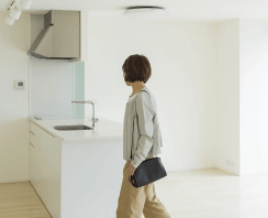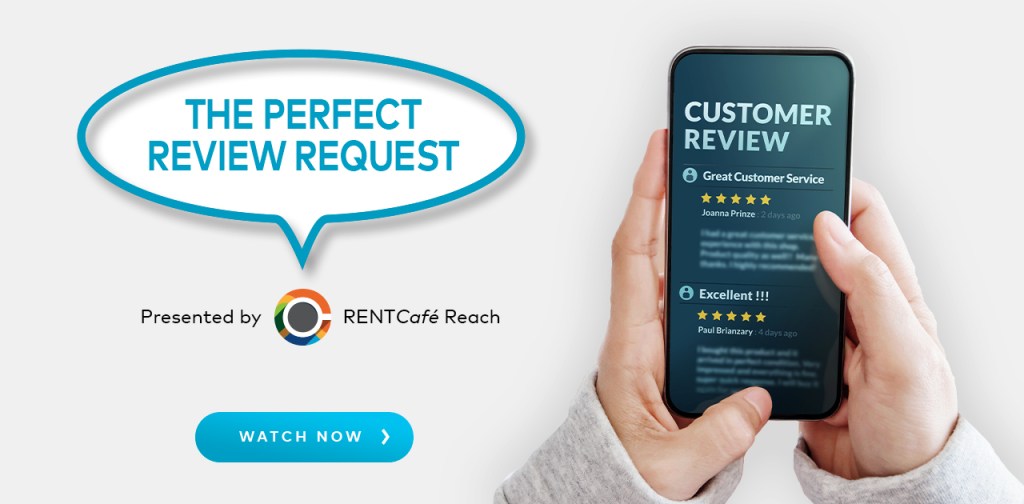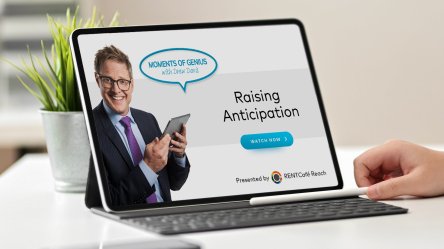When it comes to increasing revenues, decreasing vacancies is a no brainer. Keeping units occupied with optimal rent flow is a foundation for good performance. One way that you can limit vacancies is to list units as soon as you know the current renter will not renew their lease. Listing rentals while they are still occupied can offer significant benefits if you’re able to work through the challenges. Why list an occupied unit? Historically, property managers list an empty (or soon to be empty) unit. When the desired unit is occupied, prospects are instead shown a beautifully decorated model. Today’s renters, however, have different expectations. They want to see the exact unit that they plan to rent. Renters are more likely to sign a lease when they know exactly what they’re getting. But that’s not the only reason to list an occupied unit. Listing an occupied rental comes with these benefits as well. Listing a unit before the current tenant moves out minimizes the risk of vacancy, which leads to uninterrupted cash flow for you. The average cost of vacant unit is up to $1,750 per month, according to SmartMove data. Other sources estimate costs anywhere from $1,500 – $5,000 per month. That’s money to bolster your bottom line. When you list a property before it’s vacant, you may find a renter more quickly and skip paying utilities during the vacancy period. That translates to money saved. This is especially important for properties in the hot and humid south and southeastern U.S. In these regions, drywall is prone to mold and mildew when central air conditioning is shut off. Additionally, you could skip transferring the utilities to and from the property account during periods of vacancy. You have better things to do with your time than sit on the phone with the utility company. Time is money, and you’re saving both when utilities are switched seamlessly between renters. Challenges of listing an occupied unit Listing an occupied unit can be a huge time and money saver. To receive those benefits, there are a few challenges that you may have to overcome. Listing the occupied unit requires collaboration. You’ll need the agreement of the occupant to photograph or record the unit for a virtual tour. You may choose to offer an incentive to motivate renter participation. Remember: you only need to do this once, as you can reuse images of the furnished unit in the future. An occupied space may limit marketing options. This is particularly true for single family rentals. With signage, you risk a passerby ringing the doorbell to inquire about the property. Without signage, people passing by may not know the home is for rent. When you skip signage, a strong online marketing plan is essential. Consider advanced search marketing services to boost leads by up to 160%. The occupant’s furniture placement may not optimize the square footage of the unit or show off its best features. A couch covering an unused fireplace or a bedroom overstuffed with furniture are just two challenges of a home that isn’t professionally staged. Depending on the occupant, you may negotiate rearranging a few things. Should you show an occupied unit? There are a lot of variables to consider if you choose to show an inhabited rental. First, consider if it’s necessary. In high demand markets, renters may be willing to sign a lease without a live tour. That will save you time, money and hassle. Get the latest report on your market’s performance. If showings are an essential part of moving inventory in your area, consider the following: Pets may adversely impact showings. Per the Allergy and Asthma Foundation of America, about 30% of Americans have pet allergies. Prospects may be put off by pet odors and noise as well. Make arrangements for pet-inhabited units. Resident cleanliness is difficult to manage. A messy rental may be a deterrent to...
Marketing Metrics
5 to Track
“Half the money I spend on advertising is wasted. The trouble is, I don’t know which half.” Does this sound familiar? Even though these words were said by retail magnate John Wanamaker more than 100 years ago, they still ring true today to many in real estate. With the broad expansion of the digital marketplace and corresponding rapid shifts in consumer behavior, there are more places than ever to advertise your properties, all at varying costs and success rates. But how do you know which advertising sources are working? The answer is marketing data, something that’s widely available today given the online customer journey. “Marketing analytics give you the information you need to positively impact your company’s bottom line,” said Esther Bonardi, vice president of marketing at Yardi. “Most property marketers look at cost per lease, often attributing the lease to the source that drove the first customer contact, but there is so much more data now that you need to take into consideration.” Keep an eye on these five property marketing metrics and you’ll be better able to drive revenue, reduce wasted advertising spend and plan for the future. 5 Marketing Metrics Every Property Marketer Should Know 1. Total Exposure What: A percentage that tells you how many total units are available for rent, including month-to-month and expiring leases.Why: Before you decide where to market, you need to decide how much marketing to do. If your exposure is low, it might be a good month to cut back. If it’s high, it’s probably time to ramp up spend. 2. Occupancy Trends What: A review of what percentage of units are occupied, examined on a month-by-month basis over a period of time.Why: Reviewing last year’s occupancy trends can give you a good idea of...
Online Marketing that Works
New Resources on MHN
Do you want to excel in marketing and optimize your multifamily property performance? Of course, you do. With a little (free) help from the experts, reaching both goals is simpler than you may think. Multi-Housing News Marketing Resources Multi-Housing News (MHN) is a digital magazine that provides leaders in the multifamily housing industry with the most current news, information and analysis. Its content helps decision makers run their businesses more efficiently and profitably. The ongoing ascent of online marketing highlights a need for insightful, practical and timely marketing content. This spring, we proudly introduce Multifamily Marketing Resources, a user-friendly repository of content to help get the right eyes on your property. Explore articles, videos, reports and more to help you get the most out of your marketing spend. What online marketing tips and tricks can you learn on MHN? MHN publishes daily, which means that you get the freshest insights to help you stay ahead of the marketing game. Get an array of timely tips and hacks to make marketing easier. Below is just a sneak peek at what you can find. Is your website working for you? Your website is no longer just a first impression. It may be your only chance to stand out from the competition. Prospects use websites and their online tours to narrow down potential properties. “There has been a fundamental shift from the website as a marketing channel to the website as part of the tour,” said Esther Bonardi, vice president of corporate & multifamily marketing at RentCafe and Yardi. “Today, leasing activity starts earlier and it starts on the website. I don’t think this is a passing fad just related to the pandemic,” Bonardi added. “I think these behaviors will stick, especially as we see new Gen Z renters coming into the renter marketplace. Their shopping behaviors were shaped right now at this moment in time. But even for the rest of us, I think the pandemic has gone on long enough that it has reshaped customer behavior.” Read Attracting and Converting Potential Renters with Your Website to learn how you can transform your website into a more powerful marketing tool. Create email subject lines that won’t be ignored Every email that you send is battling against dozens of competitors in your prospects’ inbox. The time and creativity that you put into your email won’t fulfill their potential if the email goes unread and deleted. To improve your open and click through rates, there are five main things to consider. These three are a great place to start: Prompt people’s curiosity: Make them want to click to see what’s inside the email. Is it an offer? A new resident service or amenity?Make sure the email is formatted well: Create subject lines that are 60 characters or fewer with the important words near the front of the subject line.Avoid clickbait-y phrases: Be compelling and transparent. Don’t say they’ve won something if they haven’t or create a false sense of urgency. Read Email Subject Lines That Work in Apartment Marketing for additional ways to get your emails opened, read and engaging readers. More marketing goodness to explore on MHN The field of online marketing constant evolves. Best practices, new techniques and trends can be a lot for small teams to manage. Fortunately, the team at MHN makes it easy for you to stay abreast of the latest in multifamily marketing. Get marketing goodness sent directly to your inbox. Simply subscribe to the monthly digital...
Loyalty, Referrals and NOI
Resident Engagement for the Win
Want to build renter loyalty, earn referrals and celebrate your awesome residents at the same time? We’ve got three great ways to support stronger net operating income (NOI) by celebrating your residents. Happy residents will save you time and money Summer heralds warm weather, group gatherings and celebrations. These events are a natural way to promote engagement amongst residents and staff. Such engagement builds a sense of community, an important part of nurturing resident loyalty and referrals. Resident retention is essential to stronger NOI. Per the National Apartment Association, it costs anywhere from $1,000 to $5,000 to turn a unit. If a community could reduce turnover by just one per month, they could save $20,000 in annual expenses and about 96 hours of maintenance labor. Referrals also play a strong role in improved NOI. Happy residents will refer their neighbors, which cuts your marketing spend. Per Harvard Business Review, it costs a business about 5-25x more to acquire a new customer than it does to sell to an existing one. One way to cut costs at your property is to invest in events that enrich resident engagement and satisfaction. Black History Month (February), Women’s History Month (March), Asian Pacific American Heritage Month (May) and several designated heritage days offer opportunities to celebrate your residents. Foster a sense of belonging and resident satisfaction with the fun ideas below! Amplify voices When we feel seen and heard, we feel welcomed. Consider opportunities that empower residents to use their voices and share their stories. Use your resident app to share short stories. When your locality permits, host performances of resident-written skits and poetry. Celebrate unique cultures through the arts Create events around food, music and other arts to unite the community in the celebration. Food brings people together. Considering an event catered by locally owned and ethnically diverse restaurants. During social distancing, you could also encourage residents to share recipes. It’s a fun and approachable way to explore cultures with all of our senses! Music, whether lyrical or instrumental, tells the stories of our unique journeys in relatable ways. Consider creating and sharing playlists of artists from the featured cultural group. (Apple Music does this if you need inspiration.) You can also integrate the music during group classes such as yoga or spin. Allow students to explore the theme of the class when booking through your property concierge. Visual arts are perhaps the easiest way to celebrate cultural groups while implementing social distancing. Participants can share photos of their art, crafts and heirlooms and tag your property on social media. Artists may also display prints of their work in the community center or in a temporary, outdoor gallery. The possibilities are endless! Mindful messaging Celebrating an unfamiliar heritage can be daunting. What you say, how and when you say it could make or break an engagement initiative. In addition to amplifying diverse voices, you may consider learning the basics of social media messaging for organizations. The National Institute for Social Media has resources on social listening, crisis management and messaging. There are basic toolkits to help you craft effective messaging on solidarity and inclusion. By celebrating and engaging residents, you support the sense of community that leads to retention and referrals. Join a webinar to learn how you can promote resident engagement with simple, online...
Google Ad Updates
Tips for PPC Success
Surprise! Google is changing its match types again. This is the fifth time that Google has changed match types. And as we all know, algorithms are constantly evolving as well. We’re here to help you out with a quick overview of what’s changed, how it might help, and who benefits most. So long and goodbye beloved match type! The Google Ads that we all know and love have four match types. From least to most restrictive they are broad, modified broad, phrase and exact. In 2010, Google introduced modified broad. It accounted for misspellings, different tenses, and keywords presented in different order. It bridged the gap between the array of relevant queries that searchers submitted and who marketers intended to reach. In 2014, broad match improved so that the structure of the keyword mattered less. Searchers would submit queries with or without necessary hyphens and spaces. “3 bedroom garden style apartments in Philly” and “3 bedroom garden-style apartments in Philadelphia” would behave the same. Marketers were in love. Broad match became one of the most popular and successful match types alongside phrase. It offered flexibility, versatility and ease of use. Now we’re saying goodbye. What’s changed as of Feb 2021? Modified broad match type is being eliminated in July 2021. You won’t be able to add any keywords to this match type. Phrase match is incorporating behaviors of modified broad. In doing so, Google aims to simplify keyword usages and make it easier to find more relevant customers. Moving forward, both match types will have the same matching behaviors to the same traffic. This change isn’t entirely surprising. A lot of specialists have noticed that the lines between the two match types have been blurring for about a year now. What we wonder, though, is how Google will take into account when keyword order is necessary. Someone searching for “units converted from factory to lofts in Minneapolis” will not be equally as interested in “units converted from lofts to a factory.” That would make for confusing and uncomfortable living conditions. Google reports that this will be taken into account, but not much detail is given. Why is Google changing its match types and what are the advantages? Per Google, The Rule of Close Variance and other factors make it so that there is no need to have two distinct types. The algorithm has gotten smarter and “learned” to decipher what advertisers and searchers intend when using modified broad and phrase match types. You may feel that’s a lot of trust to put into artificial intelligence. It is. But less hands-on engagement with match types can free up marketers to other creative tasks that are not so easily automated. There is also greater potential for traffic. More traffic could be good. The PPC community has mixed feelings about these changes. That’s okay. Is the PPC advertising community pleased to see the merging of the match types? Feedback varies. In an interview on the topic, PPC expert Mark Irvine states that each change to keyword match types brings “a lot of unpredictability to advertisers” and “may not lead to more [desirable] traffic.” Advertisers will have to re-work their strategies without the guarantee that they’re gaining efficacy in marketing. The boost in volume without greater specificity means that there is a small risk of getting more irrelevant traffic. This could also mean increased spend without increased conversions. Irvine notes that only accounts that get more traffic from phrase match keywords should expect an increase in their ad impressions, clicks, costs and conversions. Conversely, ads from modified broad match keywords and other match types will see a decrease in engagement or no change. Marketing expert Brett McHale adds that the recent change “blurs the lines between match types” and strongarms advertising into relying on Google’s recommendations. “The change to phrase match and phasing out of modified broad match appears to me to be...
Gen Z Renters
Next Generation Expectations
The oldest members of Gen Z are turning 24 this year. They were just seven years old when Facebook launched and 13 when Instagram came along. They have never known a time without the internet. And they’re poised to be the largest generation of renters ever. Just when we’ve adapted to Millennial renters, this new generation enters the market with its own set of renter preferences. But how different are they, really? A rentcafe.com survey of 2,500 renters revealed what Gen Z renters are looking for in their next apartment. First, see the results from that survey in an infographic that you can share. Then, get some tips for attracting and retaining Gen Z residents. Finally, watch a video interview with a Gen Z renter who shares her take on today’s online experience. Infographic: Gen Z renter preferences Gen Z is a generation of digital natives who value technology above most traditional amenities. They search for apartments on Google, check out reviews first and consider high-speed internet to be more important than onsite parking! While Gen Z renters may just be entering the market, their preferences indicate future multifamily trends. For example, this generation is 2x more interested than previous generations in smart home features like locks and thermostats. So for now, smart home features are nice to have. But in the future, will they be considered a must-have to demand the best rent rates? 3 tips for marketing apartments to Gen Z renters The results of this survey were also discussed during the keynote address of the Apartment Innovation and Marketing (AIM) Conference’s virtual Reconnect event. In the presentation, Drew Davis, award-winning marketer and author, and Esther Bonardi, vice president of marketing at Yardi, shared strategies to attract and retain the newest generation...
Let’s chat
Picking the right chatbot
Property management chatbots have been a hot topic lately, especially for multifamily rentals. A chatbot can meet renters’ increasing demands for digital communication and capture more leasing opportunities, but only if it’s used wisely. First, we’ll talk about why you should consider “hiring” a chatbot if you don’t have one on staff already. Then, we’ll show you three things your apartment rental chatbot should be able to do. Finally, watch a short video to get chatbot tips from expert marketer Drew Davis, who spent months talking to chatbots in different industries to see what works and what doesn’t. Why a chatbot? Employing a chatbot as part of your customer experience team can ensure you never miss an incoming leasing opportunity, day or night, and it frees up onsite staff to focus on assisting applicants and residents. If you don’t have a chatbot yet, you’re probably losing leases to competitors that do. That’s because customers expect instant and accurate answers to their questions. They hate waiting. In fact, in a survey on response times that included more than 3,000 customers, 88% of respondents expected a response within an hour, with 33% of them saying they expect an answer in 15 minutes or less. Is that realistic for your agents, especially when you factor in after-hours contacts? Probably not. That’s where a chatbot comes in handy. But do people really want to talk to a bot? Recent data says they do. The 2020 NMHC/Kingsley Apartment Resident Preferences Report found that 48% of renters say they would use a chatbot in their next rental search. That number is anticipated to grow as chatbot adoption becomes increasingly common across multiple industries. A 2019 report by Chatbots Life predicts that chatbots will handle 85% of human interactions online within...
Senior Living Ebook
Marketing with RentCafe Reach
Online searches have become the favored route for seniors seeking a residential community. That’s why senior living community operators increasingly turn to search engine optimization (SEO) to help prospective residents find their properties. A powerful tool supporting that effort is RentCafe Reach Senior Living, an advanced online marketing services solution that enables execution of SEO plus pay-per-click advertising, social media posting and reputation management from a single platform. Yardi is spreading the word about this platform and the online marketing experts who support it with a new ebook, titled “4 Ways to Get Found Online.” The publication illustrates how RentCafe Reach Senior Living: Creates an exceptional online presence that fills vacancies. Increases traffic with optimized content that positions communities for maximum search visibility. Drives leads with impactful ad campaigns, managed by AdWords specialists. Keeps pace with Google’s algorithm changes. Formulates and executes a full marketing plan tailored to a community’s goals. Engages prospects with curated social media local content and boosted posts. Strengthens reputation control by monitoring and responding to online reviews. As the ebook says, “The right digital marketing strategy makes all the difference, but building out a plan – and sticking to it – takes dedicated resources, consistent research and lots of elbow grease.” Read it to discover how RentCafe Reach Senior Living makes the process much easier and...
Tips for Thriving
With Senior Living Marketing
The senior housing industry is taking steps to transitioning from the COVID-19 era with policies that emphasize safety and resident service. Nicole Moberg, COO of Atlanta-based Thrive Senior Living, offers insight into successfully marketing senior communities during and after the pandemic. Below are excerpts from her recent interview with Multi-Housing News. How has the outbreak impacted Thrive Senior Living communities? Moberg: From early on, we were one of the first senior living communities to prioritize testing—backing our belief that every resident and team member should be tested as often as possible for the safety of the residents as well as our community. We also developed the “Take Off to Thrive” marketing concept, with a 30-day new resident communication checklist. This served to minimize resident isolation and loneliness and even included an adapted red carpet “landing day/move-in” experience. We view our communities as the safest place to be [with our] proper training and education, personal protective equipment, disinfection procedures and aggressive COVID-19 testing programs. How have your marketing strategies changed? Moberg: We pivoted by creating COVID-19 sales strategies including altering our messaging to focus more on care and safety and how we can help people during challenging times. Digitally, we worked to bring on a chief storyteller who showed a behind-the-scenes look at Thrive culture, created a YouTube channel to share online content to increase awareness when families could not visit and increased online presence as we allocated more toward digital spend to drive more traffic to our website. We saw increased sales throughout the pandemic with safely executed event activity. What role does technology play in your marketing? Moberg: We sourced a new video app that allows us to send videos to prospects as a follow-up; a platform to enhance virtual tours; a “thank you”...
Digital Marketing
Strategies for Multifamily
Property marketing — once constrained to classified ads, flyers and yard signs — has largely gone digital over the last two decades. And while most multifamily property management companies market their properties and vacancies online in one way or another, many aren’t using digital marketing to its fullest potential yet. Done well, digital marketing is part of a comprehensive strategy that attracts renters no matter where they search. It creates a cohesive customer experience that helps turn more leads into leases. And it gives you the data you need to keep building on your success. Let’s take a closer look at digital marketing for property management, what it entails and how you can benefit, as well as how you can get help when you need it. What is digital marketing? Per the American Marketing Association: Digital marketing refers to any marketing methods conducted through electronic devices. The includes online marketing efforts conducted on the internet. In the process of conducting digital marketing, a business might leverage websites, search engines, social media, video, email and similar channels to reach customers. Digital marketing can also be referred to as online marketing and search marketing. What does digital marketing include? A holistic digital marketing strategy includes multiple channels that complement each other, creating a consistent brand and customer experience everywhere prospects encounter your business. Digital marketing practices evolve as the way we use the internet changes, but these are some of the most common methods: Search engine optimization (SEO): SEO is the process of improving ranking with major search engines to increase unpaid online traffic to owned websites. Search engine marketing (SEM): SEM is the use of paid online advertising to increase website visibility within search engines. It’s often used together with SEO to create a stronger...
Online Marketing
Ebook for Senior Living
Knowing what not to do is as important as understanding what should be done. That’s a key takeaway from a new Yardi ebook designed to help senior living communities market their offerings effectively. “8 Do’s & Don’ts for Senior Living Community Websites” offers tips for sprucing up digital curb appeal, maximizing the impact of a website’s most visited pages and more. The list of “dos” includes showing multiple views of a floor plan, helping prospects identify the unit that meets their needs and boosting traffic by sharing images on social media. The “don’ts” address rising above a bad user experience, avoiding inferior photography, not expecting photos to speak for themselves and resisting the impulse to mimic competitors. Looking for new ways to use your marketing website to make your senior living community both more visible and more appealing to prospective residents? Read the ebook for all the do’s and don’ts of getting those prospects to your page and into your...
And Action!
Video Skills for Leasing Agents
As leasing technology and the customer journey has evolved, so has the role of the leasing agent. Also called leasing consultants or leasing specialists, these are the people who help walk prospects through the process of becoming residents … a path that’s become increasingly virtual. Even before the COVID-19 pandemic, renters were doing most of their apartment research online, often deciding which properties to tour based on apartment listing sites, review sites and branded social media accounts. Then, when social distancing measures became the norm, people started relying even more heavily on online content — including pre-recorded video tours and livestreams with leasing agents — to choose their next home. In fact, a recent survey revealed that “renters are becoming so comfortable with renting digitally, that 72% say they would rent an apartment without ever seeing the property in person if a 3D virtual tour was offered.” What does this mean for you, the person responsible for leasing apartments? It means it’s time to improve your video skills. Here are some tips to help you get more comfortable behind the camera as well as in front of it. (Don’t worry, no previous filmmaking experience is required.) Filming Want to shoot a video tour that converts? Even if you’re just filming with your phone, considering these three things will set you up for success: Video orientation — If you’re trying to decide whether to shoot in portrait or landscape, ask where the video will be posted. Horizontal videos with a landscape orientation will usually look best on your website and YouTube. But you should hold your camera upright to take a video with a portrait orientation for Instagram Stories or a livestream with a prospect who is using their phone. Either format works well for Facebook, but apartments look more spacious when shot in landscape, so that’s what we recommend. Lighting — If you have a window in every room and great natural light, use it. If not, it’s best to shoot early or late in the day, with every light on in the unit, so it looks bright and there’s not too much contrast with the light outside. Audio — Sound can be a tricky thing, especially if you’re filming in a busy apartment building. Record using the microphone in your headphones or AirPods if you can, even though you might feel silly wearing them. You can always explain that it’s for the customer’s benefit. If you are tackling a larger project, you might want to buy an inexpensive microphone to improve sound quality. Get more tips for staging virtual and self-guided tours. Starring There’s no sense in being camera shy if you’re a leasing agent. You’re the face of the property as far as prospects are concerned. If you want renters to know, like and trust you, starring in your video tours is a good idea. When filming a video with a person in it, whether that person is you or someone else, pay attention to: Head room — Head room is the amount of space between the top of your head and the top of the video. If you have too much space above your head, it will make you look like you are shrinking. Too little and you risk cutting off the top of your head, which is unsettling for the viewer. Facial expression — When you’re trying to recite a list of property features and unit updates, it can be hard to think about what your face is doing. But it’s important to avoid scowling and maintain a pleasant expression, especially for prospects you may not have connected with in person yet. Editing If you’re creating pre-recorded video tours for your property website, Facebook page or other publicly accessible platform, some simple video editing can set you apart from the competition. Apps like iMovie (free for iOS devices) and Adobe Premiere Rush (this one works...
Marketing Analytics
Create, monitor, adjust
How do you create the perfect property marketing strategy? One that delivers the biggest ROI for your budget? In the days of flyers, yard signs and billboards, creating a winning marketing program used to be somewhere between a guessing game and an art form. But now that most rental searches begin (and sometimes finish) online, successful property marketing is more of a science thanks to the amount of data available. Today, property marketers can access data on prospects, leads and leases from multiple sources. Taken as a whole, these make up the marketing analytics that can make or break your strategy. “In terms of marketing, we understand you have a few critical priorities to keep your units filled and drive good revenue. First, you have to create a marketing and lead generation strategy. Then, you have to monitor and evaluate the success of your strategy. And finally, you have to adjust your plan to make sure you are getting the very best results for the least amount of spend,” said Esther Bonardi, vice president of marketing at Yardi. “But it’s difficult to compile and compare the data you need. That’s where a lot of good marketing strategies fall apart. And it’s where RENTCafé Marketing IQ can help.” What marketing analytics are important to property marketers? To effectively increase marketing ROI and reduce spend, these are a few of the data points you should keep a close watch on: Total exposure: Understand not only current vacancy and availability, but also month-to-month leases and uncommitted lease expirations to gain a better view of your total vacancy risk and greater insight into how much marketing is needed. Prospects by source: Compare the number of prospects each source brings in. When you understand where the greatest volume of leads is coming from, you’ll know which sources are ideal for creating awareness, an especially important metric during a lease-up or rebrand. Leases by source: Compare the number of leases each source delivers over any period. Which sources are outperforming others? Are there any that aren’t performing at all? Conversion rate by source: Compare the conversion rate of each source. Getting a lot of leads is good but getting a lot of targeted leads that convert is better. Where are you seeing the most success? These are the sources you should focus your spend on when there’s a need to fill vacancies. Cost by vendor: Compare the cost of each vendor to see where you are spending the most each month. Cost per prospect: Determined by dividing the total marketing costs by the number of prospects. How much are you spending to increase brand awareness? Cost per lease: See how much you are paying for each lease. Are you paying too much to an ILS that doesn’t deliver? Where are you getting leads for less? This data point shows you where you may have opportunities to redistribute or cut your budget. Taken individually, these metrics are easy to understand. But it can be challenging to get them all in one place for analysis quarterly — let alone monthly or weekly. And how do you know you can trust the lead data sent to you by vendors? Knowing that customers interact with your brand an average of seven times before converting, how can you be sure that the leads you’re paying for truly converted because of that source? Top property marketers use marketing analytics software to aggregate and analyze this data for them. In doing so, they save time, cut through the noise and gain transparency into the success of their efforts. And while, in the past, it could be difficult to garner enthusiasm for the marketing budget from external stakeholders, analytics tools like Marketing IQ make it simple to show them the numbers to support any proposal. What’s Marketing IQ? Marketing IQ is a powerful marketing analytics tool for RENTCafé clients. It delivers fast, accurate,...
Future of Leads + Leasing...
Executive insight from Yardi
How has the pandemic permanently altered multifamily housing? This is one of the many questions explored during the 2020 National Apartment Association APTvirtual conference. The event hosted 63 breakout sessions and five TED-style Game Changer sessions that helped participants tackle tough questions. The Connect with Execs session offered a unique opportunity for guests to talk to Anant Yardi, founder and president of Yardi. Together, participants explored technologies that surged during the pandemic and are now industry standards. “The pandemic has accelerated the transition of digital media and the use of digital media,” observed Mr. Yardi. “AI is such an important topic. AI, big data and IoT are three topics that are taking a lot of attention.” He continued, “These are the technologies that are coming to the forefront. This is what we mean by innovation, bringing tech to the market for the benefit of the industry.” Artificial intelligence and apartment chatbots, our new coworkers Technologies that leverage artificial intelligence, such as chatbots, bridge the gap between live customer service and cost efficiency. Chatbots permit leasing agents to focus on high-value tasks instead of repetitive inquiries. When leasing agents are not available, chatbots offer a natural supplement to their services. RentCafe Chat IQ can guide prospects through the leasing journey by readily presenting information on pricing and availability, tour scheduling, pet policies and more. It communicates via chat and text and will soon have capabilities for emails, calls and in-app messages. Chatbot interactions are natural, intelligent and accurate. The engine has learned, for example, that “What r ur business hours” is actually the question “What are your business hours?” It uses natural language processing to understand typos and improper grammar. Machine learning enables AI engines to adapt to human speech and writing patterns. With each...
What Renters Want
Self-Guided Tour Success Tips
Do you know what your prospects want in an apartment tour? Esther Bonardi, vice president of marketing at Yardi, hosted “OPTECH Express: The New Apartment Tour — Insights for Today’s Customer Preferences” as part of NMHC OPTECH 2020. The mini session gave insights into the latest renter preferences. Bonardi also offered actionable tasks to carry property managers into the future of touring. RentCafe.com surveys reveal what renters want To better understand renter preferences, Yardi issued two surveys. The May survey published by RentCafe.com revealed that 83% of renters would take a self-guided tour if it was offered to them. When asked why they would take a self-guided tour, the results were surprising. “About 63% of respondents said they wanted to tour at their own time and their own pace. That had nothing to do with social distancing,” observes Bonardi. “So we might say from that, it’s likely that people want this for other reasons, and it will continue to be important long beyond the pandemic.” Yardi focused on Gen Z and Millennial renters during the fall survey. Results reveal that 52% of respondents preferred a non-agent-led tour, included self-guided and virtual. Nearly 43% said they would still love to work with an agent. “These are important numbers to keep in mind,” says Bonardi. “Those numbers tell us that we have to offer options. One tour type is no longer enough to meet the changing demands of our customers. We need to let them decide what options they want to tour the apartment home.” Tips for offering new tour types “Don’t offer a new tour type just to check a box,” advises Bonardi. “Gather with your team and figure out how to make each tour feel as personal and connected as possible. After all, this...
Advanced Marketing Tools...
For Senior Living
What is lead attribution and how can it help senior living community operators get the most out of their marketing spend? Lead attribution is the process of determining how leads from a Facebook page, Google ad, directory listing or other source become associated with a property. Understanding all sources that a prospect touches on the path to becoming a resident can help property managers determine how to allocate their marketing money and staff resources most efficiently. RentCafe Senior CRM illuminates lead attribution with a “lead journey” feature that shows how many prospects who became residents spent time on the Facebook page or follow a Google ad to the website. The lead attribution report, another element of the solution, analyzes data to reveal, among other things, the organization’s top sources for prospects. Other reports illustrate the top and bottom sources for resident conversions. The system assigns scores for each source using attribution models that split prospects across the sources in their journey and includes prospects who submitted an inquiry and toured the community. Yardi Senior CRM scores all sources that contributed to a prospect’s inquiry, with full drilldown to the score’s elements. Marketing managers might want more nuanced source information than just “property website” from a lead that comes into RentCafe Senior CRM from a website. What’s of greater value to them is the site the visitor was on when they clicked the link that brought them to their site. RentCafe Senior CRM tracks the true source of a lead journey when a prospect submit information from the “Contact us” of “Schedule a tour” page of a Yardi-hosted website. With these data and analytics, which include each marketing touchpoint that contributed to a lease and not just the first source that generated the lead, sales...
Reputation Management
5 Ways to Stay on Top
In the age of online everything, it takes a lot more than a good website to stay on top. Ratings and reviews are the new “word of mouth” for multifamily properties, so it’s critical to proactively monitor and protect your online reputation. Here are five reputation management strategies to make sure your communities get the attention of potential renters for all the right reasons. Claim your local listings and review profiles No, we don’t mean your vacancy listings. Local listings refer to every mention of your business on the web. According to BrightLocal’s 2019 Local Consumer Review Survey, 90% of consumers used the internet to find a local business in the last year, with 33% looking one up every day, so claiming your online listings and review profiles are more important than ever. To appear in local results for searches like “apartments for rent in [your city],” you must make sure your business name, address and phone number are consistent across every website. This is sometimes referred to as your NAP (Name/Address/Phone). In an article for Marketing Land, research director Pamela Parker asserts, “It is critical to claim your local listings by providing accurate information to search engines and online directories (namely Google, Facebook, Apple Maps, Bing and Yelp) … Claiming your listings also gives the site publisher a direct, verified relationship with your organization. It establishes your brand as the listing’s owner and gives you control over all content and updates.” It’s important to remember that claiming your listings isn’t something you do just once. You should schedule annual or biannual audits to make sure your business profile remains up to date — and that no one has added inaccurate information. Ask for reviews If you’re listed on a review site, but don’t have any reviews, potential renters will likely pass you over for a competitor with more and better ratings. BrightLocal found that the average consumer reads 10 reviews before trusting a business and visiting your website. But incentivizing reviews is frowned upon by the big players, like Google and Yelp, and most consumers say they can spot a fake review. So how can you get more authentic, positive reviews more quickly? Award-winning marketer Drew Davis shares the secret in this episode of Moments of Genius. Reply to reviews We’ve all been told that we should reply to every review. But does anyone read your responses? In a word: yes. The same BrightLocal consumer review survey discovered that 97% of people read businesses’ responses to reviews. While it’s nice to respond to positive reviews, renters are looking closely to see how you respond to negative reviews. Are you aware of the issue? Did you try to resolve the conflict or offer a solution? No matter how inaccurate or unfair you feel the review is, it’s important to show empathy. Read more tips for responding to negative reviews. Monitor the competition Ever wondered what people think about the competition? Now it’s easy to find out and see how you stack up. Read competitor reviews to see what renters like and don’t like about their properties. Then, use that information to level the playing field or even get ahead. For example, if you find out that renters love the neighboring property’s amenities but don’t feel a sense of community, you may want to update your website to highlight those elements. You could add amenity photos and pictures of community events as well as a calendar showing virtual and in-person activities available to your residents. Analyze customer sentiment While reading (and responding) to every review is key, it’s also important to keep an eye on the big picture. Gathering feedback in the form of online reviews is pointless if you’re not analyzing customer sentiment to strategically promote change. Sentiment analysis often goes beyond star ratings to identify specific keywords that with positive and negative connotations, giving you more insight into...
Yardi + AIM
Live webcast Sept. 17
Are you missing live events? While we can’t bring back the hum of the tradeshow floor just yet, we’re excited to team up with AIM to host a live webinar event that we hope will rival some of your favorite speaking sessions from conferences past. Keep reading to see how we’re bringing industry leaders from Bozzuto, KETTLER and The Management Group together on one virtual stage … and why you want to reserve your seat asap. The New Apartment Marketing Playbook: Consumer Behavior Has Shifted, Have You? Thursday, Sept. 17, 11 a.m. PDT Even as the COVID-19 pandemic continues, renters are still on the move. With social distancing measures in place, renters expect to interact with properties in new ways. This increasing demand for virtual and contactless engagement is nothing new. But now that we’ve adapted to a new norm and the virtual conveniences that come with it, there’s no going back. Considering this shift in consumer behavior, here are some questions your property management teams may be facing: Is it possible to create an online experience as powerful as a visit to your properties? How can you offer game-changing online and self-service tools that don’t compromise your security standards? What should your leasing agents be doing to pivot and provide real value in an increasingly virtual world? “Don’t lose customers to your competitors while you’re waiting for things to ‘get back to normal.’ Normal as we knew it is changing. Taking this opportunity to make smart updates to your leasing process will have a lasting positive impact on your business in the months and years ahead,” said Esther Bonardi, session moderator and vice president of marketing at Yardi. During this live online event, you will learn how to: Convert more renters by creating authentic experiences onlineLease more units by offering a range of tour types to fit every needImprove the prospect experience while prioritizing the safety of your team and propertiesEvolve leasing positions to meet the demands of the new customer experience Speakers include: Jamin Harkness, Executive Vice President, The Management GroupKelley Shannon, Senior Vice President, Marketing & Customer Engagement, BozzutoDaryl Smith, Senior Vice President & Chief Marketing Officer, KETTLER Free ebook Webinar registrants will receive a free copy of The New Apartment Tour with their confirmation email. This exclusive ebook details three ways you can modernize different tour types at your properties to convert more renters, both online and in person. Save your seat today to get your...
5 Happy Moments
Better timing = better reviews
Want better ratings and reviews for your properties? Take the advice of award-winning marketing expert Drew Davis and create moments of inspiration (MOI) for your renters. “If we want better ROI, we need to focus on MOI,” said Davis. “Meaningful micromoments define your experience, differentiate your service and truly build your brand.” In episode 5 of Moments of Genius, he tells property teams to ask themselves, “When is our afterparty glow moment?” Put another way, when are your residents most likely to be happy about the place they call home? Because that’s the perfect time to ask for a positive property review. If you haven’t seen the episode yet, watch it now. Then keep reading to discover five ideal times to ask residents to share a review — as well as a few surprising moments when you should put the request on hold. Picking up the keys In most cases, few things are more exciting than picking up the keys to a new apartment. It’s a fresh start, a new opportunity to create the home of your dreams. Amplify that feeling by giving your new renter a welcome gift and asking if they want their picture taken holding the keys. Follow up the next day to make sure everything in their apartment is working as expected and then, after they’ve settled in, ask for a review of their move-in experience. Getting an appliance fixed You know what’s not fun? Having a broken appliance. But do you know what’s amazing? When that broken washer, oven or garbage disposal is working again! If your maintenance team is doing an awesome job of following-up on maintenance requests (especially right now, with people spending more time at home due to the coronavirus pandemic), be sure to ask for...
Increase Tour ROI
6 steps from tour to lease
Sure, you’re booking more tours. But are you converting them? Here are six steps you can take every time a tour is booked that will help you get the lease. Customize your confirmation As soon as a prospective resident makes an appointment, you should send out a confirmation that includes all the necessary information (e.g. date, time, location, contact info). Ideally, your CRM system will automate that step for you, so your agents don’t have to manually respond 24/7. Each email should be customized to make the guest feel special. How do you customize an automated email? First, add their name to the email so it says something like, “Hi Jared, we’re so excited for your visit next Tuesday at 9:30 a.m.” Then, take it to the next level by asking a question. You can do something like: Upon your arrival we want to welcome you with a beverage of choice. Do you prefer x or y? We have a welcome gift for your tour. Would you prefer x or y? Both ideas work well for agent-led and self-guided tours, but even with virtual tours you can come up with creative ideas for gifts. You can easily email something like a Starbucks gift card or a coupon book for area businesses. Raise anticipation After you’ve confirmed the tour, raise anticipation to make sure your prospects don’t cancel or lease from a competitor. You can do this in several ways. One of the easiest methods is to take a quick video of yourself with your phone. In the video, you should greet them by name, show them something compelling about the unit or property and say that you can’t wait tour with them. Get other ideas that will help you raise anticipation in this episode...




















